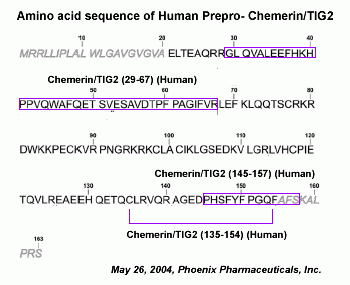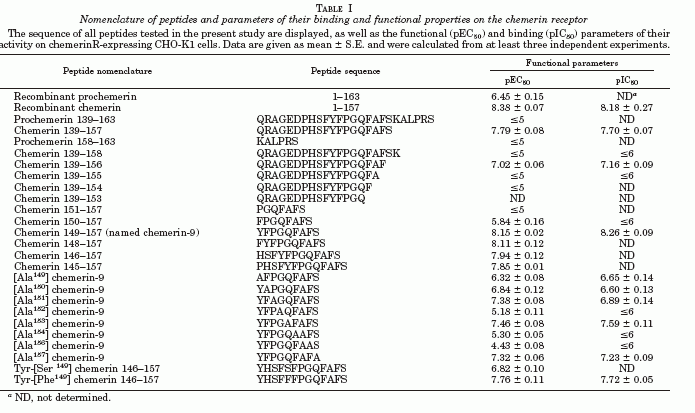

Dendritic cells (DCs) and macrophages are professional antigen-presenting cells (APCs) that play key roles in both innate and adaptive immunity. ChemR23 is an orphan G protein-coupled receptor related to chemokine receptors, which is expressed specifically in these cell types. Here we present the characterization of chemerin, a novel chemoattractant protein, which acts through ChemR23 and is abundant in a diverse set of human inflammatory fluids. Chemerin is secreted as a precursor of low biological activity, which upon proteolytic cleavage of its COOH-terminal domain, is converted into a potent and highly specific agonist of ChemR23, the chemerin receptor. Activation of chemerin receptor results in intracellular calcium release, inhibition of cAMP accumulation, and phosphorylation of p42-p44 MAP kinases, through the Gi class of heterotrimeric G proteins. Chemerin is structurally and evolutionary related to the cathelicidin precursors (antibacterial peptides), cystatins (cysteine protease inhibitors), and kininogens. Chemerin was shown to promote calcium mobilization and chemotaxis of immature DCs and macrophages in a ChemR23-dependent manner. Therefore, chemerin appears as a potent chemoattractant protein of a novel class, which requires proteolytic activation and is specific for APCs.
Wittamer V, Franssen JD, Vulcano M, et al. J Exp Med. 2003;198(7):977-85.
Chemerin is a novel protein identified as the natural ligand of ChemR23 (chemerinR), a previously orphan G protein-coupled receptor expressed in immature dendritic cells and macrophages. Chemerin is synthesized as a secreted precursor, prochemerin, which is poorly active, but converted into a full agonist of chemerinR by proteolytic removal of the last six amino acids. In the present work, we have synthesized a number of peptides derived from the C-terminal domain of human prochemerin and have investigated their functional properties as agonists or antagonists of human chemerinR. We found that the nonapeptide (149)YFPGQFAFS(157) (chemerin-9), corresponding to the C terminus of processed chemerin, retained most of the activity of the full-size protein, with regard to agonism toward the chemerinR. Extension of this peptide at its N terminus did not increase the activity, whereas further truncations rapidly resulted in inactive compounds. The C-terminal end of the peptide appeared crucial for its activity, as addition of a single amino acid or removal of two amino acids modified the potency by four orders of magnitude. Alanine-scanning mutagenesis identified residues Tyr(149), Phe(150), Gly(152), Phe(154), and Phe(156) as the key positions for chemerinR activation. A modified peptide (YHSFFFPGQFAFS) was synthesized and iodinated, and a radioligand binding assay was established. It was found that the ability of the various peptides to activate the chemerin receptor was strictly correlated with their affinity in the binding assay. These results confirm that a precise C-terminal processing is required for the generation of a chemerinR agonist. The possibility to restrict a medium sized protein to a nonapeptide, while keeping a low nanomolar affinity for its receptor is unusual among G protein-coupled receptors ligands. The identification of these short bioactive peptides will considerably accelerate the pharmacological analysis of chemerin-chemerinR interactions.
Wittamer V, Grégoire F, Robberecht P, Vassart G, Communi D, Parmentier M. The C-terminal nonapeptide of mature chemerin activates the chemerin receptor with low nanomolar potency. J Biol Chem. 2004;279(11):9956-62.
The orphan receptor ChemR23 is a G-protein coupled receptor (GPCR) with homology to neuropeptide and chemoattractant receptors. Tazarotene, a synthetic retinoid activating retinoic acid receptor (RAR), up-regulates tazarotene-induced gene-2 (TIG2). The function and molecular target of this protein are now described. By means of reverse pharmacology screening using a peptide library generated from human hemofiltrate, we have isolated and identified TIG2 as the natural ligand of ChemR23 and report the specific molecular form of the bioactive, circulating TIG2, representing the amino-acid residues 21 to 154 of the 163 amino acid-containing prepropeptide. Based on the expression pattern of ChemR23 and TIG2, the physiological role in bone development, immune and inflammatory responses and the maintenance of skin is now being investigated.
Meder W, Wendland M, Busmann A, et al. Characterization of human circulating TIG2 as a ligand for the orphan receptor ChemR23. FEBS Lett. 2003;555(3):495-9.

Social Network Confirmation